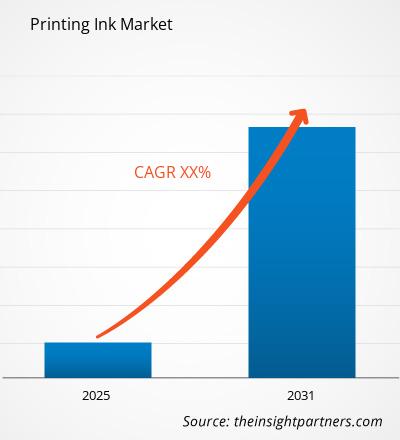Analyst Perspective
The global Printing ink market is expected to register a CAGR of 5.9% from 2022 to 2031. The printing ink market is experiencing growth due to an increasing demand in the packaging & labelling sector, coupled with rising needs from the digital industry. The development of low-cost technologies could be an opportunity for the printing ink market. Rising demand for bio-based printing is a significant factor influencing the growth of the printing ink market. Increasing demand for a lithographic process which is used in cloth, foil, plastic, etc., helps in the growth of printing ink market. Stringent guidelines related to printing ink may hinder the growth of the printing ink market.
Market Overview
Printing Inks are pigments of the required colors mixed with oil or varnish. Printing inks are used for several purposes, including publications, graphics, packaging, and others. The rise in the packaging industry, publication, and commercial printing applications has driven the ink market. Adopting eco-friendly inks helps address consumer expectations and the industry's commitment to environmental responsibility, marking positivity towards sustainable practices.
Market Drivers
- Increase in demand from the packaging sector.
Packaging plays a significant role in brand differentiation. Since packaging attracts consumers, manufacturers invest highly in unique and attractive packaging. The growing demand for environmental sustainability pushes individuals to adopt eco-friendly practices, leading to the demand for bio-based and water-based printing inks.
- Increase in demand for energy-curing inks.
Energy curing technology includes UV-cured inks, solvent inks, solid inks, and others. Energy-curated inks dries up quickly. It increases performance and productivity; it is environmentally friendly is a significant growth-driven factor for energy-curing inks.
Market Segmentation
The global printing ink market is segmented based on type, process, and application. The global printing ink market is segmented based on type: solvent-based, water-based, oil-based, and UV-curated. The printing ink market is segmented based on process into lithographic, flexographic, gravure, digital, and others. Based on application, it is segmented into packaging and labels, commercial printing, decorative printing, textiles, and others.
Regional Analysis
The report provides a detailed industry overview, which includes qualitative and quantitative information. It also provides an overview and forecast of the global printing Ink market based on several segments. Additionally, it provides market size and forecast estimates from 2021 to 2031 concerning five major regions: North America, Europe, Asia-Pacific (APAC), Middle East & Africa (MEA) and South & Central America. The regional Printing Ink market is also sub-segmented by respective countries and segments. The Printing Ink market report covers a complete analysis and forecast of eighteen countries globally and the prevailing trends and opportunities in the region.
The report analyses factors affecting the Printing Ink market from both the demand and supply side. Furthermore, it evaluates market dynamics during the forecast period, i.e., drivers, challenges, opportunities, and future trends. The report also provides an extensive Porter's Five Forces analysis highlighting factors affecting these regions' Printing Ink markets.
Key Players
The reports cover vital organic and inorganic growth strategy developments in the food emulsifiers market. Various companies concentrate on organic growth strategies such as product launches, approvals, patents, and others. Inorganic growth strategies activities noted in the market were acquisitions, partnerships & collaborations. These activities have paved the way for the development of the business and customer base of market players. Market players in the printing Ink market anticipate profitable growth opportunities with the rising demand from packaging sector in the global market.
The report includes key companies' profiles, SWOT analysis, and Printing Ink market strategies. The report also focuses on leading market players with information including company profiles, components, and services offered, financial information for the last three years, and critical development in the past five years.
Below is a list of companies engaged in the Printing Ink market.
- Wikoff Color Corporation
- Flint Group
- Sakata Inx Corporation
- DIC Corporation
- Huber Group
- Royal Dutch Printing Ink Factories Van Son
- Siegwerk Druckfarben Ag & Co. Kgaa
- Deers I Co. Ltd
- Zeller + Gmelin Corporation
- T&K Toka Corporation
Printing Ink Report Scope
| Report Attribute | Details |
|---|---|
| Market size in 2024 | US$ XX million |
| Market Size by 2031 | US$ XX Million |
| Global CAGR (2025 - 2031) | XX% |
| Historical Data | 2021-2023 |
| Forecast period | 2025-2031 |
| Segments Covered |
By Type
|
| Regions and Countries Covered | North America
|
| Market leaders and key company profiles |
- Historical Analysis (2 Years), Base Year, Forecast (7 Years) with CAGR
- PEST and SWOT Analysis
- Market Size Value / Volume - Global, Regional, Country
- Industry and Competitive Landscape
- Excel Dataset



Report Coverage
Revenue forecast, Company Analysis, Industry landscape, Growth factors, and Trends

Segment Covered
This text is related
to segments covered.

Regional Scope
North America, Europe, Asia Pacific, Middle East & Africa, South & Central America

Country Scope
This text is related
to country scope.
Trends and growth analysis reports related to Chemicals and Materials : READ MORE..
The List of Companies
1.Flint Group
2.DIC Corporation
3.Siegwerk Druckfarben AG and Co. KGaA
4.Sakata Inx Corporation
5.TandK TOKA Corporation
6.Dainichiseika Color and Chemicals Mfg. Co., Ltd.
7.DEERS I CO., Ltd.
8.Epple Druckfarben AG
9.TOYO INK SC HOLDINGS CO., LTD.
10.Hubergroup
11.TOKYO PRINTING INK MFG CO., LTD.
12.AkzoNobel NV
13.PPG Industries, Inc.
14.Valspar Corporation
15.Sun Chemical Corporation
16.ALTANA
17.Arkema
18.Nippon Paints
19.ColorMatrix
20.Zeen Enterprises

 Get Free Sample For
Get Free Sample For